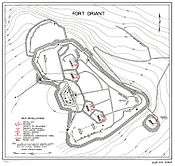Battle of Fort Driant
| Battle of Fort Driant | |||||||
|---|---|---|---|---|---|---|---|
| Part of World War II, Lorraine Campaign | |||||||
 An American P-47 Thunderbolt dive bombing Fort Driant before the initial attack | |||||||
| |||||||
| Belligerents | |||||||
|
|
| ||||||
| Commanders and leaders | |||||||
|
George S. Patton (Third Army) Walton Walker (XX Corps) Stafford LeRoy Irwin (5th Infantry Division ) |
Otto von Knobelsdorff (1st Army) Heinrich Kittel (Metz garrison) | ||||||
| Strength | |||||||
| ~10,000 | ~1,300-3,000 | ||||||
| Casualties and losses | |||||||
| 64 killed, 547 wounded, 187 missing and assumed captured | Unknown | ||||||
The Battle of Fort Driant was a constituent battle in the 1944 Battle of Metz, during the Lorraine Campaign and the greater Siegfried Line Campaign. The battle was on occupied French territory between the forces of the United States Third Army under the command of General George S. Patton and the forces of Nazi Germany under General Otto von Knobelsdorff.
Location and Fortifications

Fort Driant was located five miles southwest of Metz, just west of the Moselle River.[1] Originally built in 1902 and named after Colonel Émile Driant, the fort was continuously reinforced throughout World War II by both the French and German armies. Fort Driant was made from steel reinforced concrete, it was also surrounded by a deep dry moat and barbed wire. It housed five main gun batteries of 150mm guns, infantry trenches, and armored machine gun and observation posts. From its commanding position, it could direct heavy fire in the Moselle Valley. The fort could also bring down flanking fire that produced heavy casualties amongst the men of General Walton Walker's XX Corps.[2]
Background
Third Army's intelligence section had already determined that the Germans intended to make the most of the ring of forts around Metz, the ancient gateway city through which so many invading armies had passed. Metz was to be the linchpin in the Germans' defensive strategy. An army had not directly taken the city since 1552. It had been captured after a 54-day siege during the Franco-Prussian War and had been fortified by the Germans in World War I. However, the string of fortresses were left in ruins.[3]
When the U.S. Third army arrived at Metz, they were quickly drawn into a stalemate with the German defenders for weeks over control of the city and its perimeter. Upon sustaining heavy losses attacking the fortifications, it was clear to the Americans that Fort Driant would have to be taken to establish effective control of the fortifications around the city. Patton declared the fort an easy target, and committed elements of the 5th Infantry Division to the attack.
Battle
At 14:15 on September 27, 1944 P-47 Thunderbolts from the XIX Tactical Air Command began bombing Fort Driant. Companies E and G of the 11th Infantry Regiment, and the attached Company C, 818th Tank Destroyer Battalion began their attack on Fort Driant. Small arms fire, machine guns and mortars immediately began firing upon the advancing troops. Most of the fort was below ground, causing the tank destroyers to be ineffective against the heavily armored pillboxes. After the initial attack faltered, the Americans withdrew to the original position at 18:30[4] The attack resumed on the 29th with bulldozers to fill in the fort's trench line and the support of Company C, 735th Tank Battalion, pushing explosive-filled pipes called "snakes" in front of their tanks. The bulldozers and snakes proved to be of little help as during the second attack the bulldozer experienced mechanical difficulties and the snakes were either damaged (bent) or would not work as intended. Upon reaching the perimeter, the German defenders were ready. Fierce hand-to-hand fighting with grenades and bayonets broke out between the two sides. E Company managed to capture the southernmost barracks or barracks "R" and found an underground passage. The passage was heavily defended by machine guns and sniper fire, making exploitation of the tunnel an impossibility. The Germans lost roughly a quarter of the fort before the Americans withdrew having 21 officers and 485 men. A further attack on Fort Driant was deemed too costly as German fire proved too accurate.
Aftermath
By October 9, Patton chose to bypass Driant. The men of the 5th Infantry Division were thought to be becoming battle fatigued, and other line correcting operations were taking place around Metz with much greater success.[5] Major General S. Leroy Irwin was given the blame for the failure at Fort Driant, he being stated as "moving too slow" and "removing the drive" of the battalion early during the initial attacks in September.[6] When Metz fell in December 1944, Fort Driant capitulated to the 5th Infantry Division at 3:45pm on December 8, surrendering uncaptured.[7] It was discovered among the prisoners that there were several units of the 17th SS Panzer Grenadier Division, along with the remnants of the German 1217th Grenadier Regiment and the III. Battalion of the Officer Training Regiment, which may have contributed to the Germans' stiff resistance.
References
- ↑ "Archived copy" (PDF). Archived from the original (PDF) on 2011-07-21. Retrieved 2011-02-02.
- ↑ "Archived copy" (PDF). Archived from the original (PDF) on 2011-07-21. Retrieved 2011-02-02.
- ↑ "Archived copy". Archived from the original on 2010-09-08. Retrieved 2011-01-13.
- ↑ The German Fortress of Metz 1870-1944. Osprey Publishing. 2008-09-23. ISBN 9781846033025.
- ↑ Rickard, John Nelson (2004-06-01). Patton at Bay: The Lorraine Campaign, 1944. Brassey's. ISBN 9781574887822.
- ↑ Rickard, John Nelson (2004-06-01). Patton at Bay: The Lorraine Campaign, 1944. Brassey's. ISBN 9781574887822.
- ↑ "Archived copy". Archived from the original on 2011-05-21. Retrieved 2011-03-16.
- Metz, 1944 One More River World War Two Books
Coordinates: 49°04′22″N 6°02′49″E / 49.07278°N 6.04694°E